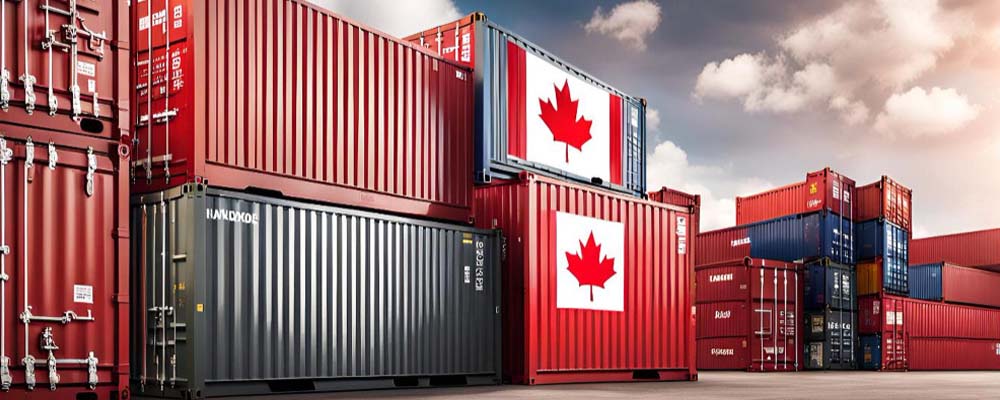
Exporting to Canada offers a wealth of opportunities for businesses looking to expand their market reach. For freight forwarding companies, logistics providers, and e-commerce businesses, understanding the nuances of the Canadian market is crucial to success. This comprehensive guide will walk you through everything you need to know about exporting to Canada, from regulatory environments to risk management, ensuring your business is well-prepared to thrive north of the border.
Understanding the Canadian Market
Canada is a vast and diverse country with a robust economy and a strong demand for a wide range of products and services. For exporters, it’s essential to grasp the key characteristics of the Canadian market:
- Economic Stability: Canada boasts one of the most stable economies in the world, making it an attractive destination for international trade. The country’s GDP growth, low unemployment rates, and high standard of living contribute to a favorable business environment.
- Consumer Preferences: Understanding the preferences of Canadian consumers is vital. There’s a growing demand for sustainable, high-quality products. Canadians value ethical practices and are willing to pay a premium for goods that align with these values.
- Market Size and Diversity: Canada is the second-largest country by land area, with a population of nearly 38 million. The market is diverse, with significant regional variations in preferences and purchasing power. Tailoring your products and marketing strategies to specific regions can be a game-changer.
Regulatory Environment
Navigating the regulatory environment is a critical aspect of exporting to Canada. Compliance with Canadian laws and regulations ensures smooth operations and avoids potential legal issues:
- Import Regulations: The Canada Border Services Agency (CBSA) governs import regulations. It’s essential to understand the classification, valuation, and origin rules for your products to ensure they meet Canadian standards.
- Trade Agreements: Canada has several trade agreements, including the United States-Mexico-Canada Agreement (USMCA) and the Comprehensive Economic and Trade Agreement (CETA) with the European Union. These agreements provide preferential treatment and reduced tariffs for certain goods, making it easier to export to Canada.
- Product Standards and Certifications: Depending on the type of product you’re exporting, you may need to comply with specific standards and obtain certifications. This could include health and safety regulations, labeling requirements, and environmental standards.
 Shipping and Logistics
Shipping and Logistics
Efficient shipping and logistics are paramount for successful exports to Canada. Here’s what you need to know:
- Transportation Modes: Canada has a well-developed transportation infrastructure, including road, rail, air, and sea routes. Depending on the nature of your products and their final destination, you can choose the most suitable mode of transportation.
- Shipping Costs: Calculating shipping costs accurately is crucial for pricing your products competitively. Factors such as distance, weight, and shipping method all play a role in determining costs.
- Logistics Partners: Partnering with reliable logistics providers is essential. They can help you with warehousing, distribution, and last-mile delivery, ensuring your products reach Canadian consumers in a timely manner.
Customs Procedures
Understanding customs procedures is essential to avoid delays and ensure a seamless export process:
- Documentation Requirements: Accurate documentation is critical for customs clearance. Common documents include the commercial invoice, bill of lading, packing list, and certificates of origin. Ensuring these documents are complete and accurate can prevent costly delays.
- Customs Duties and Taxes: Be aware of the applicable customs duties and taxes for your products. The CBSA provides detailed information on tariffs and taxes, including the Harmonized System (HS) codes used to classify goods.
- Customs Brokers: Engaging a customs broker can streamline the customs clearance process. These professionals have expertise in navigating the complexities of customs regulations, ensuring your shipments clear customs without unnecessary complications.
 Payment Methods and Financial Considerations
Payment Methods and Financial Considerations
Choosing the right payment methods and managing financial considerations are critical for smooth transactions:
- Payment Terms: Determine suitable payment terms for your Canadian buyers. Common payment methods include letters of credit, documentary collections, and open account transactions. Each method has its pros and cons, so choose one that aligns with your risk tolerance and business needs.
- Currency Exchange: Managing currency exchange is vital when dealing with international transactions. Fluctuations in exchange rates can impact your profit margins. Consider using forward contracts or other hedging strategies to mitigate currency risk.
- Financing Options: Explore financing options to support your export activities. Export Development Canada (EDC) offers various financial products and services to help businesses expand internationally, including export credit insurance and working capital solutions.
Marketing and Sales Strategies
Effective marketing and sales strategies are essential to penetrate the Canadian market successfully:
- Market Research: Conduct thorough market research to identify your target audience and understand their needs and preferences. Utilize online tools, surveys, and focus groups to gather valuable insights.
- Brand Positioning: Develop a strong brand positioning that resonates with Canadian consumers. Highlight the unique value propositions of your products and emphasize qualities like sustainability, quality, and innovation.
- Digital Marketing: Leverage digital marketing channels to reach your audience. Invest in search engine optimization (SEO), social media marketing, and content marketing to increase your online visibility and attract potential customers.
 Customer Service and Support
Customer Service and Support
Providing exceptional customer service and support is crucial for building long-term relationships with Canadian customers:
- Customer Communication: Maintain clear and open communication with your customers. Address any inquiries promptly and provide timely updates on order status and delivery.
- After-Sales Support: Offer after-sales support to ensure customer satisfaction. This could include warranty services, product returns, and technical assistance.
- Feedback Mechanisms: Implement feedback mechanisms to gather customer opinions and suggestions. Use this feedback to improve your products and services continuously.
Intellectual Property Protection
Protecting your intellectual property (IP) is vital when exporting to Canada:
- Register Trademarks and Patents: Register your trademarks and patents with the Canadian Intellectual Property Office (CIPO) to safeguard your brand and inventions.
- IP Enforcement: Be proactive in enforcing your IP rights. Monitor the market for potential infringements and take legal action if necessary.
- Confidentiality Agreements: Use confidentiality agreements when sharing sensitive information with partners, distributors, or employees to protect your proprietary knowledge.
Risk Management
Mitigating risks is essential for successful exports:
- Market Risks: Stay informed about market trends and economic conditions in Canada. Diversify your market presence to reduce dependency on a single market.
- Operational Risks: Develop contingency plans to address potential disruptions in your supply chain, transportation, and production processes.
- Compliance Risks: Stay up-to-date with regulatory changes and ensure your business practices comply with Canadian laws and standards.
Sustainability and Ethical Practices
Incorporating sustainability and ethical practices into your business operations can enhance your brand reputation and appeal to Canadian consumers:
- Sustainable Sourcing: Source your raw materials and products from suppliers that adhere to sustainable and ethical practices.
- Eco-Friendly Packaging: Use eco-friendly packaging materials to reduce your environmental footprint and appeal to environmentally conscious consumers.
- Corporate Social Responsibility (CSR): Implement CSR initiatives that benefit local communities and contribute to social and environmental causes.
 Conclusion
Conclusion
Exporting to Canada offers immense opportunities for businesses looking to expand their global footprint. By understanding the Canadian market, navigating regulatory environments, optimizing shipping and logistics, and implementing effective marketing strategies, you can successfully tap into this lucrative market. Prioritizing customer service, protecting intellectual property, managing risks, and adopting sustainable practices will further enhance your chances of success. Ready to take the plunge? Start your export journey to Canada today and unlock new growth opportunities for your business.




 Shipping and Logistics
Shipping and Logistics Payment Methods and Financial Considerations
Payment Methods and Financial Considerations Customer Service and Support
Customer Service and Support Conclusion
Conclusion



